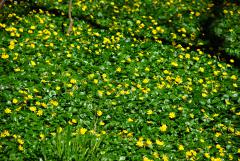Ranunculus ficaria

Dense carpets of kidney-shaped leaves and yellow flowers in early spring help identify lesser celandine, a rampantly invasive non-native plant.
Photographer: Flickr user Adam Fagen
Find out more on NatureServe Explorer
Search for photos of this species within the NatureServe Flickr photo stream.
Lesser celandine, or fig buttercup is a seriously invasive plant from Eurasia. (Its scientific name is also known as Ficaria verna.) It has escaped to the wild in most states of the U.S. and grows densely along some floodplains and rich, mesic areas nearby. It emerges green very early in spring and makes a yellow carpet of flowers.
So what's wrong with that? Just this: it blocks much-needed sunlight from the soil in early spring. Native wildflowers called spring ephemerals only make it in the world by taking advantage of the sunny days in spring before trees leaf out and shade the ground. Early-growing lesser celandine beats them to the punch, shading out the beautiful native spring ephemerals which would normally provide food or shelter for butterflies and other insects and birds and other critters, which each in turn provide some benefit for others. This interrupts a whole web of healthy interdependencies in nature!
Lesser celandine reproduces by dividing like other bulbs do - but rampantly. So in a short time it threatens the well-being of whole swaths of natural communities on floodplains and low slopes... and everything connected to them.


